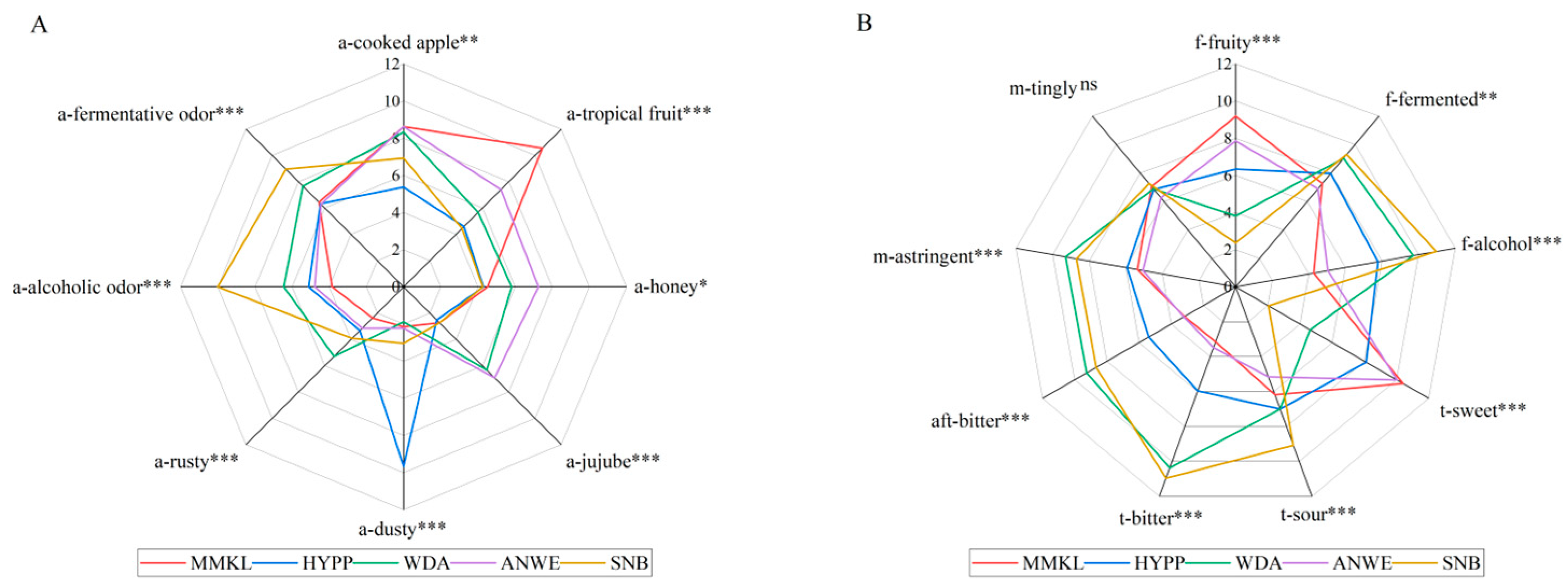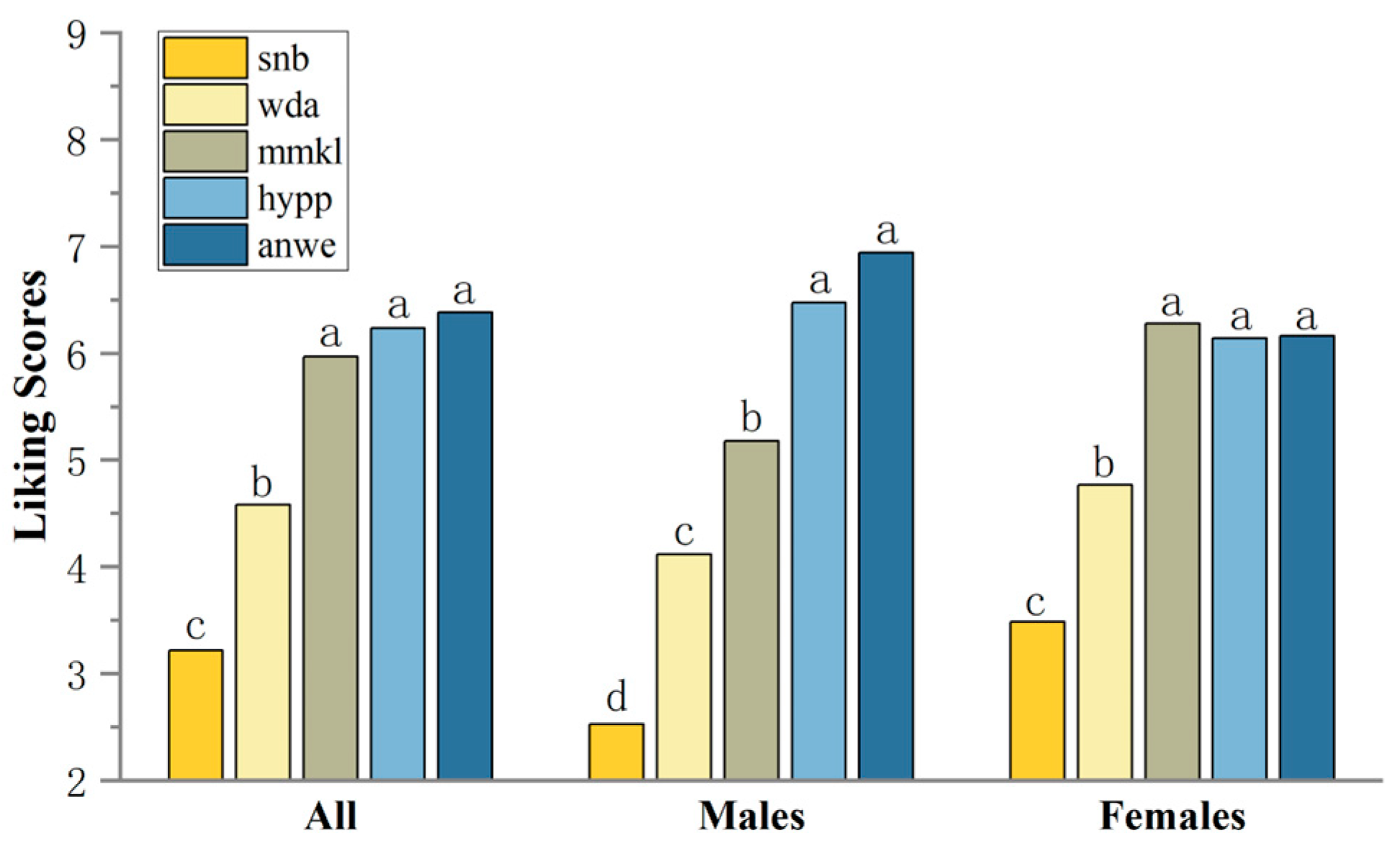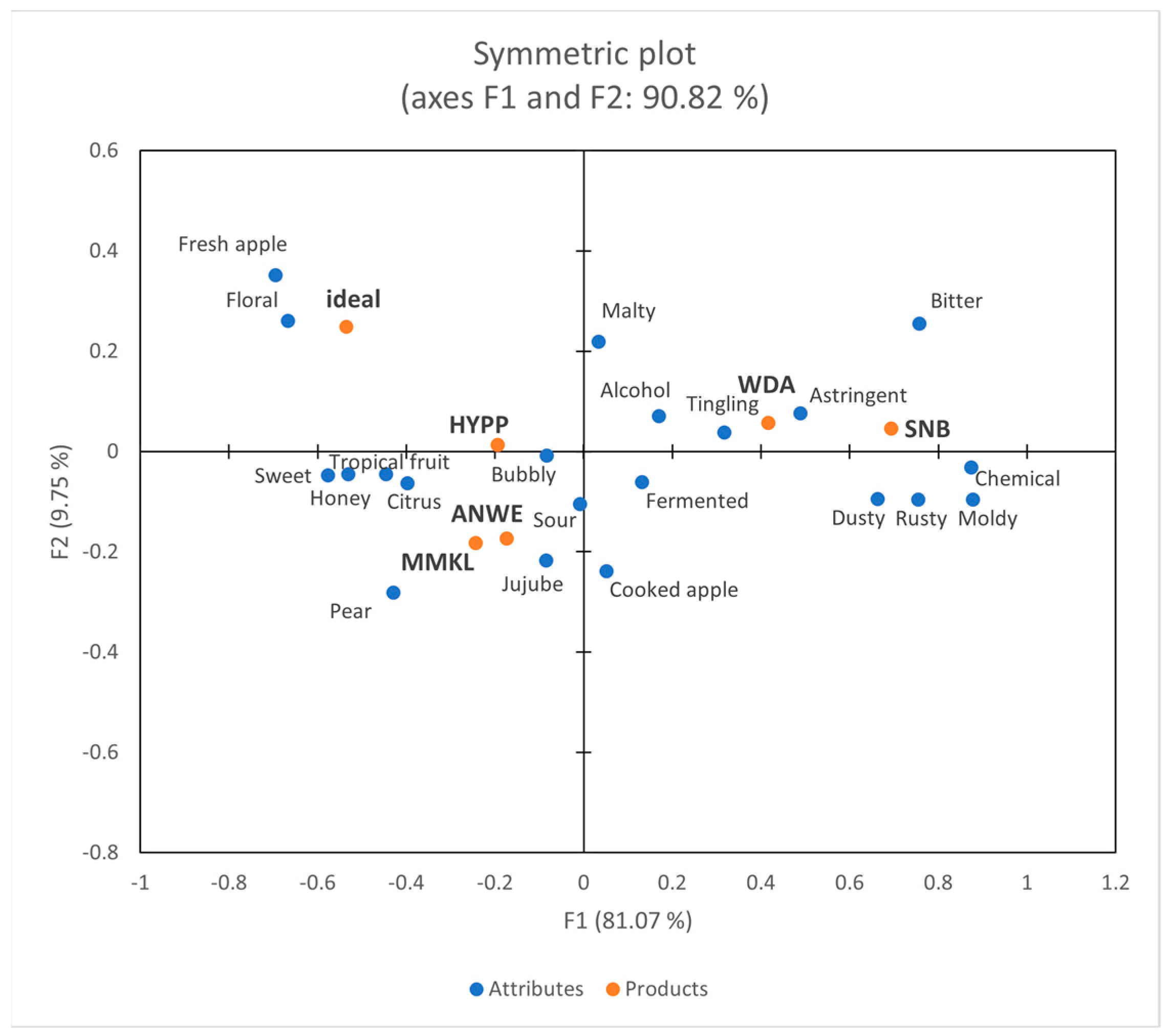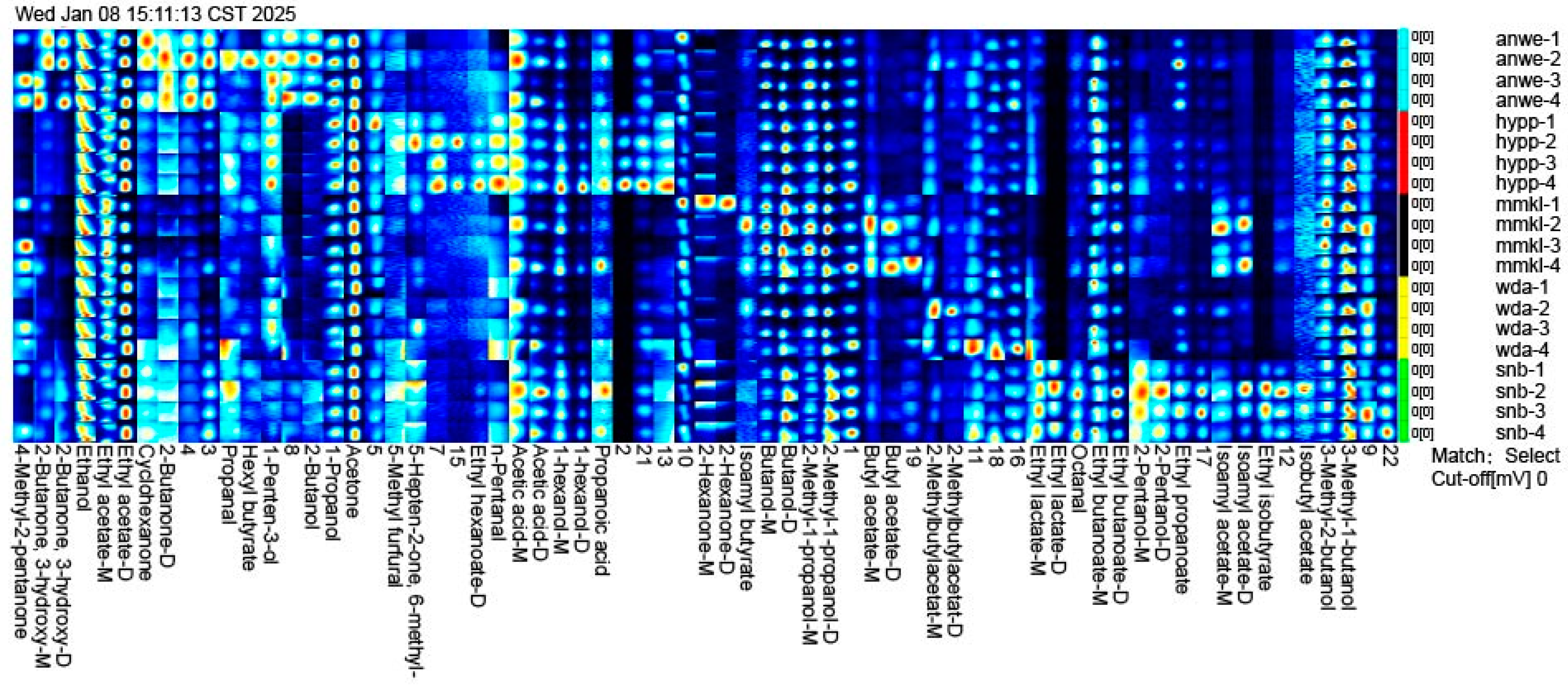Aroma Release and Consumer Perception During Cider Consumption
Abstract
:1. Introduction
2. Materials and Methods
2.1. Cider Samples
2.2. Chemicals
2.3. Quantitative Descriptive Analysis
2.4. Check-All-That-Apply
2.4.1. Sensory Lexicon
2.4.2. Procedure
2.5. Aroma Analysis
2.5.1. Volatile Compounds of Cider
2.5.2. Oral Aroma Detection After Drinking Cider
2.6. Statistical Analysis
3. Result and Discussion
3.1. Sensory Evaluation
3.2. Consumer Perception
3.3. Aroma Release During Cider Consumption
3.3.1. Volatile Compounds of Cider
3.3.2. Oral Aroma Release
3.4. Correlations Between Sensory Perception and Aroma Release During Cider Consumption
4. Conclusions
Author Contributions
Funding
Institutional Review Board Statement
Informed Consent Statement
Data Availability Statement
Conflicts of Interest
References
- Xu, J.; Guo, L.; Wang, T.; Ma, M.; Wang, B.; Wei, X.; Fan, M. Effect of Inorganic and Organic Nitrogen Supplementation on Volatile Components and Aroma Profile of Cider. Food Res. Int. 2022, 161, 111765. [Google Scholar] [CrossRef] [PubMed]
- He, W.; Liu, S.; Heponiemi, P.; Heinonen, M.; Marsol-Vall, A.; Ma, X.; Yang, B.; Laaksonen, O. Effect of Saccharomyces Cerevisiae and Schizosaccharomyces Pombe Strains on Chemical Composition and Sensory Quality of Ciders Made from Finnish Apple Cultivars. Food Chem. 2021, 345, 128833. [Google Scholar] [CrossRef] [PubMed]
- Xu, Y.; Fan, W.; Qian, M.C. Characterization of Aroma Compounds in Apple Cider Using Solvent-Assisted Flavor Evaporation and Headspace Solid-Phase Microextraction. J. Agric. Food Chem. 2007, 55, 3051–3057. [Google Scholar] [CrossRef]
- Li, Y.-N.; Luo, Y.; Lu, Z.-M.; Dong, Y.-L.; Chai, L.-J.; Shi, J.-S.; Zhang, X.-J.; Xu, Z.-H. Metabolomic Analysis of the Effects of a Mixed Culture of Saccharomyces Cerevisiae and Lactiplantibacillus Plantarum on the Physicochemical and Quality Characteristics of Apple Cider Vinegar. Front. Nutr. 2023, 10, 1142517. [Google Scholar] [CrossRef]
- Sun, B.C.; Halpern, B.P. Identification of Air Phase Retronasal and Orthonasal Odorant Pairs. Chem. Senses 2005, 30, 693–706. [Google Scholar] [CrossRef] [PubMed]
- Mu, S.; Liu, L.; Liu, H.; Shen, Q.; Luo, J. Characterization of the Relationship between Olfactory Perception and the Release of Aroma Compounds before and after Simulated Oral Processing. J. Dairy Sci. 2021, 104, 2855–2865. [Google Scholar] [CrossRef]
- Goldberg, E.M.; Wang, K.; Goldberg, J.; Aliani, M. Factors Affecting the Ortho- and Retronasal Perception of Flavors: A Review. Crit. Rev. Food Sci. Nutr. 2018, 58, 913–923. [Google Scholar] [CrossRef]
- Pérez-Jiménez, M.; Pozo-Bayón, M.Á. Development of an In-Mouth Headspace Sorptive Extraction Method (HSSE) for Oral Aroma Monitoring and Application to Wines of Different Chemical Composition. Food Res. Int. 2019, 121, 97–107. [Google Scholar] [CrossRef]
- Poinot, P.; Arvisenet, G.; Ledauphin, J.; Gaillard, J.-L.; Prost, C. How Can Aroma–Related Cross–Modal Interactions Be Analysed? A Review of Current Methodologies. Food Qual. Prefer. 2013, 28, 304–316. [Google Scholar] [CrossRef]
- Esteban-Fernández, A.; Rocha-Alcubilla, N.; Muñoz-González, C.; Moreno-Arribas, M.V.; Pozo-Bayón, M.Á. Intra-Oral Adsorption and Release of Aroma Compounds Following in-Mouth Wine Exposure. Food Chem. 2016, 205, 280–288. [Google Scholar] [CrossRef]
- Perez-Jiménez, M.; Chaya, C.; Pozo-Bayón, M.Á. Individual Differences and Effect of Phenolic Compounds in the Immediate and Prolonged In-Mouth Aroma Release and Retronasal Aroma Intensity during Wine Tasting. Food Chem. 2019, 285, 147–155. [Google Scholar] [CrossRef]
- Wu, Y.; Li, Z.; Zou, S.; Dong, L.; Lin, X.; Chen, Y.; Zhang, S.; Ji, C.; Liang, H. Chemical Composition and Flavor Characteristics of Cider Fermented with Saccharomyces Cerevisiae and Non-Saccharomyces Cerevisiae. Foods 2023, 12, 3565. [Google Scholar] [CrossRef]
- Wang, S.; Chen, H.; Sun, B. Recent Progress in Food Flavor Analysis Using Gas Chromatography–Ion Mobility Spectrometry (GC–IMS). Food Chem. 2020, 315, 126158. [Google Scholar] [CrossRef] [PubMed]
- Pu, D.; Zhang, H.; Zhang, Y.; Sun, B.; Ren, F.; Chen, H.; Xie, J. Characterization of the Oral Breakdown, Sensory Properties, and Volatile Release during Mastication of White Bread. Food Chem. 2019, 298, 125003. [Google Scholar] [CrossRef] [PubMed]
- Javier-Pisco, P.; Escriche, I.; Igual, M.; García-Segovia, P.; Pagan, M.J. Evaluation of Consumer Perception of New Aquaculture Products through Applying Focus Group and Check-All-That-Apply Methodologies. Foods 2024, 13, 2480. [Google Scholar] [CrossRef] [PubMed]
- Cole, E.; Stewart, A.C.; Chang, E.A.B.; Lahne, J. Exploring the Sensory Characteristics of Virginia Ciders through Descriptive Analysis and External Preference Mapping. J. Am. Soc. Brew. Chem. 2023, 81, 520–532. [Google Scholar] [CrossRef]
- Keller, S.T.; Harner, A.D.; Centinari, M.; Elias, R.J.; Hopfer, H. Influence of Region on Sensory and Chemical Profiles of Pennsylvania Grüner Veltliner Wines. Foods 2021, 10, 825. [Google Scholar] [CrossRef]
- Pu, D.; Duan, W.; Huang, Y.; Zhang, Y.; Sun, B.; Ren, F.; Zhang, H.; Chen, H.; He, J.; Tang, Y. Characterization of the Key Odorants Contributing to Retronasal Olfaction during Bread Consumption. Food Chem. 2020, 318, 126520. [Google Scholar] [CrossRef]
- Qin, Z.; Petersen, M.A.; Bredie, W.L.P. Flavor Profiling of Apple Ciders from the UK and Scandinavian Region. Food Res. Int. 2018, 105, 713–723. [Google Scholar] [CrossRef]
- Chu, X.; Li, Y.; Xie, Y.; Tian, D.; Mu, W. Regional Difference Analyzing and Prediction Model Building for Chinese Wine Consumers’ Sensory Preference. BFJ 2019, 122, 2587–2602. [Google Scholar] [CrossRef]
- Zhu, Y.; Su, Q.; Jiao, J.; Kelanne, N.; Kortesniemi, M.; Xu, X.; Zhu, B.; Laaksonen, O. Exploring the Sensory Properties and Preferences of Fruit Wines Based on an Online Survey and Partial Projective Mapping. Foods 2023, 12, 1844. [Google Scholar] [CrossRef] [PubMed]
- Wei, J.; Wang, S.; Zhang, Y.; Yuan, Y.; Yue, T. Characterization and Screening of Non-Saccharomyces Yeasts Used to Produce Fragrant Cider. LWT 2019, 107, 191–198. [Google Scholar] [CrossRef]
- Wei, J.; Zhang, Y.; Wang, Y.; Ju, H.; Niu, C.; Song, Z.; Yuan, Y.; Yue, T. Assessment of Chemical Composition and Sensorial Properties of Ciders Fermented with Different Non-Saccharomyces Yeasts in Pure and Mixed Fermentations. Int. J. Food Microbiol. 2020, 318, 108471. [Google Scholar] [CrossRef] [PubMed]
- Francis, I.L.; Newton, J.L. Determining Wine Aroma from Compositional Data. Aust. J. Grape Wine Res. 2005, 11, 114–126. [Google Scholar] [CrossRef]
- Lorenzini, M.; Simonato, B.; Slaghenaufi, D.; Ugliano, M.; Zapparoli, G. Assessment of Yeasts for Apple Juice Fermentation and Production of Cider Volatile Compounds. LWT 2019, 99, 224–230. [Google Scholar] [CrossRef]
- Martínez-García, R.; Roldán-Romero, Y.; Moreno, J.; Puig-Pujol, A.; Mauricio, J.C.; García-Martínez, T. Use of a Flor Yeast Strain for the Second Fermentation of Sparkling Wines: Effect of Endogenous CO2 over-Pressure on the Volatilome. Food Chem. 2020, 308, 125555. [Google Scholar] [CrossRef]
- Li, C.X.; Zhao, X.H.; Zuo, W.F.; Zhang, T.L.; Zhang, Z.Y.; Chen, X.S. The Effects of Simultaneous and Sequential Inoculation of Yeast and Autochthonous Oenococcus Oeni on the Chemical Composition of Red-Fleshed Apple Cider. LWT 2020, 124, 109184. [Google Scholar] [CrossRef]
- Song, C.; Zuo, L.; Shi, P.; Meng, J.; Wang, Y.; Zhang, Z.; Xi, Z. Aroma Characterization of Chinese Hutai-8 Wines: Comparing with Merlot and Cabernet Sauvignon Wines. Sci. Hortic. 2015, 194, 237–245. [Google Scholar] [CrossRef]
- Peinado, R.A.; Moreno, J.; Bueno, J.E.; Moreno, J.A.; Mauricio, J.C. Comparative Study of Aromatic Compounds in Two Young White Wines Subjected to Pre-Fermentative Cryomaceration. Food Chem. 2004, 84, 585–590. [Google Scholar] [CrossRef]
- Bingman, M.T.; Stellick, C.E.; Pelkey, J.P.; Scott, J.M.; Cole, C.A. Monitoring Cider Aroma Development throughout the Fermentation Process by Headspace Solid Phase Microextraction (HS-SPME) Gas Chromatography–Mass Spectrometry (GC-MS) Analysis. Beverages 2020, 6, 40. [Google Scholar] [CrossRef]
- Arcari, S.G.; Caliari, V.; Sganzerla, M.; Godoy, H.T. Volatile Composition of Merlot Red Wine and Its Contribution to the Aroma: Optimization and Validation of Analytical Method. Talanta 2017, 174, 752–766. [Google Scholar] [CrossRef] [PubMed]
- Escudero, A.; Gogorza, B.; Melús, M.A.; Ortín, N.; Cacho, J.; Ferreira, V. Characterization of the Aroma of a Wine from Maccabeo. Key Role Played by Compounds with Low Odor Activity Values. J. Agric. Food Chem. 2004, 52, 3516–3524. [Google Scholar] [CrossRef]
- Salles, C.; Chagnon, M.-C.; Feron, G.; Guichard, E.; Laboure, H.; Morzel, M.; Semon, E.; Tarrega, A.; Yven, C. In-Mouth Mechanisms Leading to Flavor Release and Perception. Crit. Rev. Food Sci. 2010, 51, 67–90. [Google Scholar] [CrossRef]
- Rossouw, M.; Geldenhuys, G.G.; Marini, F.; Manley, M. Multivariate Statistical Visualisation and Modelling of GC–MS Data for Sensory Quality Prediction of Flavoured Cider as Influenced by Storage Time and Temperature. Microchem. J. 2023, 195, 109393. [Google Scholar] [CrossRef]
- Chen, S.; Lu, J.; Qian, M.; He, H.; Li, A.; Zhang, J.; Shen, X.; Gao, J.; Xu, Y. Untargeted Headspace-Gas Chromatography-Ion Mobility Spectrometry in Combination with Chemometrics for Detecting the Age of Chinese Liquor (Baijiu). Foods 2021, 10, 2888. [Google Scholar] [CrossRef]
- Aprea, E.; Corollaro, M.L.; Betta, E.; Endrizzi, I.; Demattè, M.L.; Biasioli, F.; Gasperi, F. Sensory and Instrumental Profiling of 18 Apple Cultivars to Investigate the Relation between Perceived Quality and Odour and Flavour. Food Res. Int. 2012, 49, 677–686. [Google Scholar] [CrossRef]
- Wang, J.; Capone, D.L.; Wilkinson, K.L.; Jeffery, D.W. Chemical and Sensory Profiles of Rosé Wines from Australia. Food Chem. 2016, 196, 682–693. [Google Scholar] [CrossRef]
- Shi, N.; Li, H.-Q.; Lu, H.-C.; Tian, M.-B.; Han, X.; He, F.; Wang, J. Adjusting the Pomace Ratio during Red Wine Fermentation: Effects of Adding White Grape Pomace and Juice Runoff on Wine Flavoromics and Sensory Qualities. Food Chem. X 2023, 20, 100939. [Google Scholar] [CrossRef]






| Sample Name | Alcoholic Content (%) | Type | Ingredients | Country of Origin |
|---|---|---|---|---|
| WDA | 5 | Dry | 99.96% apple juice, SO2, and sulfites. | France |
| ANWE | 2 | Sweet | Apple juice, and SO2. | France |
| HYPP | 4.5 | Semi-sweet | Apple juice, citric acid, yeast, and sodium metabisulfite. | Poland |
| SNB | 5.5 | Dry | Apple juice, CO2, and sulfites. | Estonia |
| MMKL | 1.6 | Semi-sweet | Apple juice, CO2, and sulfites. | Estonia |
| Attributes | Reference Standards |
|---|---|
| Aroma | |
| Cooked apple | Pieces of chopped ripe apple in boiling water for 5 min. |
| Tropical fruit | Banana and pineapple slices. |
| Honey | 10 g honey. |
| Jujube | Dried jujube slices. |
| Dusty | 1 g of baking powder in 10 mL of water. |
| Rusty | Metal spoon. |
| Alcoholic odor | 10% alcohol. |
| Fermentative odor | Apple cider vinegar and white vinegar (1:1). |
| Flavor | |
| Fruity | Apple juice. |
| Fermented | Apple cider vinegar and white vinegar (1:1). |
| Alcoholic | 10% alcohol. |
| Taste | |
| Sweet | 20 g sucrose in 1 L water = 8, 10 g sucrose in 1 L water = 3. |
| Sour | 0.8 g citric acid in 1 L water = 9, 0.5 g citric acid in 1 L water = 5. |
| Bitter | 0.006 g quinine in 1 L water = 4, 0.01 g quinine in 1 L water = 12. |
| Mouthfeel | |
| Astringent | 0.6 g/L aluminum sulfate. |
| Tingly | Sparkling water. |
| Aftertaste | |
| Bitter | Steep 4 g of lotus seed core in 500 mL of boiling water for 2 min and remove = 8. |
| Code | Compounds | CAS | SNB | WDA | MMKL | HYPP | ANWE |
|---|---|---|---|---|---|---|---|
| Esters | |||||||
| e1 | Ethyl butanoate | 105-54-4 | 1.14 ± 0.014 b | 0.91 ± 0.050 b | 3.02 ± 0.25 a | 0.95 ± 0.14 b | 0.90 ± 0.090 b |
| e2 | Butyl acetate | 123-86-4 | nd | 0.31 ± 0.026 b | 1.84 ± 0.19 a | nd | 0.19 ± 0.018 b |
| e3 | Ethyl lactate | 97-64-3 | 3.69 ± 0.091 a | 0.98 ± 0.046 b | nd | 0.12 ± 0.034 d | 0.44 ± 0.074 c |
| e4 | Ethyl crotonate | 623-70-1 | nd | 0.24 ± 0.030 b | 0.16 ± 0.010 c | nd | 0.38 ± 0.047 a |
| e5 | Ethyl 2-methylbutanoate | 7452-79-1 | 0.28 ± 0.023 c | 1.14 ± 0.048 b | 1.40 ± 0.13 a | 0.29 ± 0.036 c | 1.21 ± 0.133 b |
| e6 | Ethyl isovalerate | 108-64-5 | 0.25 ± 0.016 a | nd | nd | 0.12 ± 0.017 b | nd |
| e7 | Isoamyl acetate | 123-92-2 | 1.23 ± 0.082 c | 3.02 ± 0.14 b | 3.73 ± 0.50 a | 0.29 ± 0.028 d | 0.57 ± 0.076 d |
| e8 | 2-Methylbutylacetat | 624-41-9 | 0.195 ± 0.035 c | 0.46 ± 0.044 b | 1.30 ± 0.12 a | nd | 0.16 ± 0.039 c |
| e9 | Pentyl acetate | 628-63-7 | nd | 0.044 ± 0.002 b | 0.33 ± 0.039 a | nd | nd |
| e10 | Methyl hexoate | 106-70-7 | nd | 0.024 ± 0.003 b | nd | 0.17 ± 0.020 a | nd |
| e11 | Ethyl 3-hydroxybutyrate | 5405-41-4 | nd | 0.045 ± 0.003 b | 0.177 ± 0.015 a | nd | 0.058 ± 0.006 b |
| e12 | n-Butyl butanoate | 109-21-7 | nd | nd | 0.29 ± 0.13 | nd | nd |
| e13 | Ethyl hexanoate | 123-66-0 | 5.25 ± 0.12 c | 7.33 ± 0.38 b | 1.72 ± 0.13 d | 10.07 ± 1.26 a | 2.13 ± 0.28 d |
| e14 | Hexyl acetate | 142-92-7 | 0.35 ± 0.013 d | 5.50 ± 0.24 b | 8.29 ± 1.32 a | 0.44 ± 0.063 d | 1.718 ± 0.25 c |
| e15 | Isoamyl lactate | 19329-89-6 | 1.04 ± 0.076 | nd | nd | nd | nd |
| e16 | Ethyl sorbate | 2396-84-1 | nd | nd | nd | nd | 6.04 ± 0.87 |
| e17 | Methyl octylate | 111-11-5 | nd | nd | nd | 0.80 ± 0.12 | nd |
| e18 | Ethyl benzoate | 93-89-0 | 0.96 ± 0.074 bc | 0.51 ± 0.034 cd | 0.06 ± 0.008 d | 4.88 ± 0.94 a | 1.46 ± 0.19 b |
| e19 | Diethyl succinate | 123-25-1 | 11.37 ± 0.78 a | 1.02 ± 0.15 c | 0.28 ± 0.043 c | 2.34 ± 0.27 b | 0.37 ± 0.044 c |
| e20 | Ethyl octanoate | 106-32-1 | 7.66 ± 0.64 b | 5.99 ± 0.73 bc | 1.43 ± 0.068 d | 20.55 ± 3.56 a | 2.78 ± 0.27 cd |
| e21 | Ethyl phenylacetate | 101-97-3 | 0.78 ± 0.058 a | 0.34 ± 0.004 c | 0.071 ± 0.002 d | 0.48 ± 0.082 b | 0.37 ± 0.042 c |
| e22 | Phenethyl acetate | 103-45-7 | 3.88 ± 0.38 b | 4.05 ± 0.11 b | 17.07 ± 2.25 a | 0.20 ± 0.025 c | 3.34 ± 0.32 b |
| e23 | Methyl caprate | 110-42-9 | nd | nd | nd | 0.28 ± 0.077 | nd |
| e24 | Ethyl 3-hydroxyoctanoate | 7367-90-0 | nd | nd | 1.86 ± 0.22 a | nd | 0.42 ± 0.04 b |
| e25 | Ethyl 9-decenoate | 67233-91-4 | nd | 0.30 ± 0.036 a | nd | 1.65 ± 1.06 a | nd |
| e26 | Ethyl decanoate | 110-38-3 | 2.11 ± 1.309 b | 1.64 ± 0.33 b | 0.73 ± 0.31 c | 9.90 ± 2.28 a | 3.30 ± 0.40 b |
| e27 | Phenethyl butyrate | 103-52-6 | 0.025 ± 0.013 b | 0.24 ± 0.012 a | nd | nd | nd |
| e28 | 3-Methylbutyl nonanoate | 7779-70-6 | nd | nd | 1.92 ± 1.25 | nd | nd |
| e29 | Ethyl laurate | 106-33-2 | 0.51 ± 0.26 b | 0.19 ± 0.10 b | 0.27 ± 0.071 b | 1.72 ± 0.79 a | 0.15 ± 0.011 b |
| e30 | Benzylcarbinyl caproate | 6290-37-5 | nd | 0.60 ± 0.10 a | nd | nd | 0.10 ± 0.039 b |
| Alcohols | |||||||
| alc1 | Pentanol | 71-41-0 | 0.22 ± 0.095 a | nd | 0.21 ± 0.19 a | nd | nd |
| alc2 | 2,3-Butanediol | 513-85-9 | 0.098 ± 0.006 a | 0.13 ± 0.047 a | nd | nd | 0.096 ± 0.012 a |
| alc3 | (E)-3-Hexen-1-ol | 928-97-2 | nd | 0.098 ± 0.010 b | nd | 0.24 ± 0.023 a | 0.055 ± 0.006 c |
| alc4 | Hexanol | 111-27-3 | 14.61 ± 0.83 a | 7.52 ± 0.15 c | 13.49 ± 1.24 a | 10.97 ± 1.61 b | 7.37 ± 0.54 c |
| alc5 | 2-Ethylhexanol | 104-76-7 | 0.25 ± 0.030 a | 0.037 ± 0.005 c | 0.13 ± 0.011 b | 0.056 ± 0.014 c | nd |
| alc6 | Benzyl alcohol | 100-51-6 | 0.054 ± 0.011 c | 0.21 ± 0.009 b | 0.040 ± 0.007 c | 1.27 ± 0.065 a | 0.058 ± 0.007 c |
| alc7 | 1-Octanol | 111-87-5 | 1.08 ± 0.053 a | 0.81 ± 0.015 bc | 0.57 ± 0.063 d | 0.61 ± 0.16 cd | 0.85 ± 0.12 b |
| alc8 | Phenylethyl Alcohol | 60-12-8 | 95.98 ± 7.74 a | 22.87 ± 1.78 b | 13.76 ± 1.10 c | 13.00 ± 0.75 c | 6.62 ± 0.62 c |
| alc9 | Terpinen-4-ol | 562-74-3 | 0.36 ± 0.013 a | 0.28 ± 0.006 b | nd | nd | 0.16 ± 0.028 c |
| alc10 | α-Terpineol | 98-55-5 | nd | 0.094 ± 0.005 b | 0.19 ± 0.019 b | 0.20 ± 0.054 b | 2.95 ± 0.33 a |
| alc11 | 1,3-Octanediol | 23433-05-8 | 1.06 ± 0.18 bc | 1.55 ± 0.20 b | 2.38 ± 0.43 a | nd | 0.76 ± 0.045 c |
| alc12 | Decanol | 112-30-1 | 0.13 ± 0.012 b | 0.15 ± 0.078 b | nd | 0.31 ± 0.12 a | 0.25 ± 0.043 ab |
| Aldehydes | |||||||
| ald1 | 3-Furaldehyde | 498-60-2 | 2.16 ± 0.021 a | 1.75 ± 0.090 b | 0.43 ± 0.018 d | 1.95 ± 0.23 ab | 0.67 ± 0.070 c |
| ald2 | Benzaldehyde | 100-52-7 | 0.45 ± 0.050 c | 0.27 ± 0.016 d | 0.14 ± 0.009 d | 0.81 ± 0.057 b | 1.13 ± 0.12 a |
| ald3 | Phenylacetaldehyde | 122-78-1 | 0.24 ± 0.052 a | 0.06 ± 0.004 b | nd | nd | nd |
| ald4 | Nonanal | 124-19-6 | 0.35 ± 0.044 bc | 0.48 ± 0.040 a | 0.42 ± 0.055 ab | 0.27 ± 0.053 c | 0.34 ± 0.035 bc |
| ald5 | Decanal | 112-31-2 | 0.58 ± 0.15 a | 0.59 ± 0.051 a | 0.37 ± 0.027 a | 0.47 ± 0.16 a | 0.56 ± 0.13 a |
| Ketones | |||||||
| k1 | 5-Hepten-2-one, 6-methyl- | 110-93-0 | nd | 0.089 ± 0.003 b | nd | nd | 0.12 ± 0.007 a |
| k2 | Acetophenone | 98-86-2 | nd | nd | 0.12 ± 0.013 a | 0.032 ± 0.028 b | nd |
| k3 | 2-Nonanone | 821-55-6 | 0.20 ± 0.011 b | 0.24 ± 0.007 a | 0.008 ± 0.007 d | nd | 0.096 ± 0.014 c |
| k4 | β-Damascenone | 23726-93-4 | 0.067 ± 0.006 c | 1.58 ± 0.092 a | 0.10 ± 0.019 c | 0.070 ± 0.030 c | 0.57 ± 0.070 b |
| Acids | |||||||
| acid1 | 2-Methylbutyric acid | 116-53-0 | 0.18 ± 0.012 a | nd | 0.076 ± 0.011 b | 0.12 ± 0.008 b | 0.26 ± 0.037 a |
| acid2 | Hexanoic acid | 142-62-1 | 2.46 ± 0.42 a | 2.10 ± 0.091 a | nd | nd | 1.11 ± 0.44 b |
| acid3 | 2-Ethylhexanoic acid | 149-57-5 | nd | nd | nd | nd | 2.02 ± 0.22 |
| acid4 | Octanoic acid | 124-07-2 | 7.81 ± 1.32 a | 10.18 ± 1.27 a | nd | nd | nd |
| acid5 | n-Decanoic acid | 334-48-5 | 1.01 ± 0.36 b | 9.48 ± 2.70 b | nd | nd | 32.19 ± 8.81 a |
| acid6 | Dodecanoic acid | 143-07-7 | nd | 0.094 ± 0.012 b | 0.24 ± 0.13 b | 1.71 ± 0.93 a | 0.17 ± 0.014 b |
| Others | |||||||
| ot1 | 4-Ethylphenol | 123-07-9 | nd | 1.66 ± 0.12 a | nd | nd | 0.48 ± 0.036 b |
| ot2 | 4-Tert-Butylphenol | 98-54-4 | nd | nd | nd | 1.01 ± 0.17 | nd |
| ot3 | Eugenol | 97-53-0 | 0.049 ± 0.014 c | 0.20 ± 0.021 b | 0.61 ± 0.052 a | 0.13 ± 0.098 bc | 0.57 ± 0.014 a |
| ot4 | Styrene | 100-42-5 | 0.21 ± 0.037 b | 0.39 ± 0.001 a | 0.14 ± 0.004 c | 0.14 ± 0.011 c | 0.21 ± 0.020 b |
| ot5 | D-Limonene | 5989-27-5 | nd | nd | 0.024 ± 0.005 b | 0.041 ± 0.026 b | 0.22 ± 0.019 a |
| ot6 | Myristicin | 607-91-0 | nd | nd | 1.03 ± 0.14 | nd | nd |
| Total | 170.32 | 97.76 | 80.54 | 88.69 | 85.95 |
Disclaimer/Publisher’s Note: The statements, opinions and data contained in all publications are solely those of the individual author(s) and contributor(s) and not of MDPI and/or the editor(s). MDPI and/or the editor(s) disclaim responsibility for any injury to people or property resulting from any ideas, methods, instructions or products referred to in the content. |
© 2025 by the authors. Licensee MDPI, Basel, Switzerland. This article is an open access article distributed under the terms and conditions of the Creative Commons Attribution (CC BY) license (https://creativecommons.org/licenses/by/4.0/).
Share and Cite
Chen, Y.; Zhao, R.; Jiang, G.; Liu, G.; Cao, Y.; Ye, X.; Mao, Y.; He, L.; Cheng, Y.; Tian, S.; et al. Aroma Release and Consumer Perception During Cider Consumption. Foods 2025, 14, 1005. https://doi.org/10.3390/foods14061005
Chen Y, Zhao R, Jiang G, Liu G, Cao Y, Ye X, Mao Y, He L, Cheng Y, Tian S, et al. Aroma Release and Consumer Perception During Cider Consumption. Foods. 2025; 14(6):1005. https://doi.org/10.3390/foods14061005
Chicago/Turabian StyleChen, Yuqing, Ruoqing Zhao, Guoxin Jiang, Guanchen Liu, Yanyun Cao, Xiao Ye, Yuezhong Mao, Li He, Yong Cheng, Shiyi Tian, and et al. 2025. "Aroma Release and Consumer Perception During Cider Consumption" Foods 14, no. 6: 1005. https://doi.org/10.3390/foods14061005
APA StyleChen, Y., Zhao, R., Jiang, G., Liu, G., Cao, Y., Ye, X., Mao, Y., He, L., Cheng, Y., Tian, S., & Qin, Z. (2025). Aroma Release and Consumer Perception During Cider Consumption. Foods, 14(6), 1005. https://doi.org/10.3390/foods14061005






